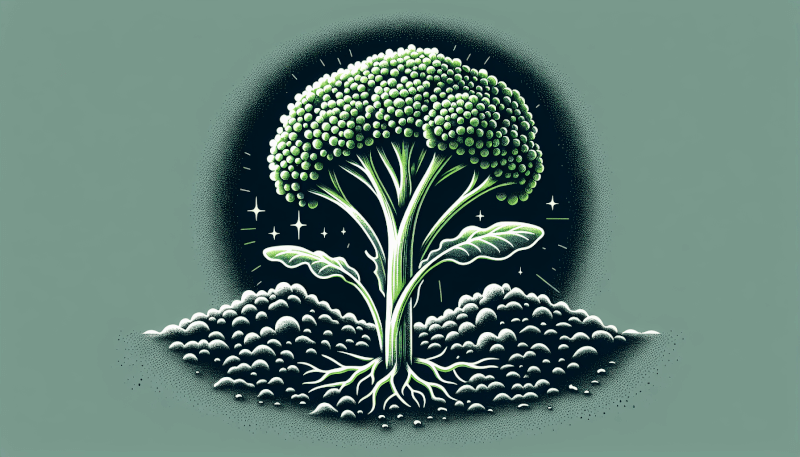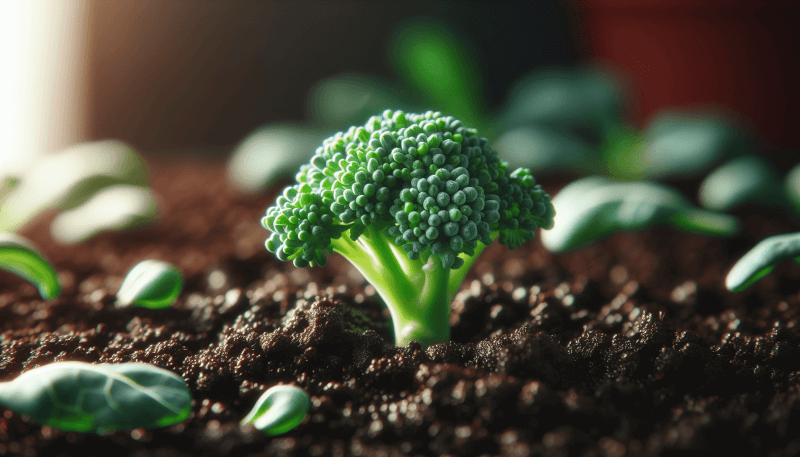👋 Click the mic button to talk to Alfred, the Todd's Seeds Gardening/Sprouting Expert – Feel free to ask him anything!
Ask Virtual Todd Anything - Click the Mic
Are you interested in growing your own broccoli at home? If so, this article is perfect for you! In this comprehensive guide, you will learn all the necessary steps to successfully plant broccoli seeds. From selecting the right seeds to providing the ideal growing conditions, we will walk you through every stage of the process. By the end, you’ll be equipped with all the knowledge and tips you need to cultivate healthy and delicious broccoli plants in your own backyard. So grab your gardening tools and get ready to embark on an exciting and rewarding gardening journey!
Choosing the Right Broccoli Seeds
When it comes to choosing the right broccoli seeds for your garden, there are a few factors to consider. The first step is determining the variety you want to grow. There are many different types of broccoli, such as heirloom varieties, hybrids, and specific cultivars. Consider factors such as taste preferences, size of the heads, and disease resistance.
Next, check the seed packet for information on the variety you have chosen. Look for details on the days to maturity, which will give you an estimate of how long it will take for your broccoli plants to produce heads. Additionally, the seed packet should provide information on the ideal growing conditions and any specific care instructions.
Considering the climate is another important aspect when choosing broccoli seeds. Broccoli is a cool-season crop, meaning it performs best in cooler temperatures. Some varieties are more tolerant of heat, while others prefer cooler climates. Take into account the average temperatures and length of your growing season to ensure you select seeds that will thrive in your specific climate.
Preparing the Soil
Before you can start planting your broccoli seeds, it’s crucial to prepare the soil properly. This will provide a healthy growing environment for your plants and help them thrive.
Start by selecting a suitable location for your broccoli patch. Ideally, the area should receive full sun for at least six hours a day. Ensure that the soil is well-drained and rich in organic matter.
Clear the area of any weeds or debris that could obstruct the growth of your broccoli plants. By removing these obstacles, you allow the broccoli to take in all the necessary nutrients and water from the soil without competition.
Testing and improving the soil is also essential for a successful broccoli crop. Conduct a soil test to determine its pH level and nutrient content. Broccoli prefers a slightly acidic soil with a pH range of 6.0 to 7.0. If necessary, make amendments to adjust the pH level or add organic matter to improve the soil’s structure and fertility.

Starting Indoors
If you want to get a head start on the broccoli growing season, starting the seeds indoors can be a great option. This allows you to control the growing conditions and give your plants a strong start before transplanting them outside.
To start indoors, use seed trays or pots with drainage holes to sow your broccoli seeds. Fill the containers with a seed starting mix, which provides a lightweight and nutrient-rich environment for the seeds to germinate. Moisten the soil before planting to ensure proper moisture levels.
Sow the broccoli seeds according to the depth and spacing recommendations on the seed packet. Typically, broccoli seeds should be planted about ¼ inch deep and spaced 2 to 3 inches apart.
In order for the seeds to germinate successfully, provide proper moisture and light. Keep the soil consistently moist but not waterlogged, and place the seed trays or pots in a warm location with ample sunlight or under a grow light.
Direct Sowing in the Garden
Direct sowing is another method to consider when planting broccoli. This involves planting the seeds directly into the garden soil, rather than starting them indoors. It is a convenient option for those who prefer to skip the indoor seed starting process.
When choosing the right time to direct sow the broccoli seeds, it’s important to consider the weather and soil temperature. Broccoli prefers cooler temperatures, so aim for sowing the seeds in early spring or late summer/early fall, depending on your growing season. The soil temperature should be around 50 to 80°F for successful germination.
Prepare the planting area by loosening the soil with a garden fork or tiller. Remove any weeds or large rocks that could hinder the growth of your broccoli plants. Rake the soil to create a smooth and level surface for sowing the seeds.
Sow the broccoli seeds according to the recommended spacing on the seed packet, typically around 2 to 3 inches apart. Gently push the seeds into the soil, covering them with a thin layer of soil. Water the area thoroughly after planting to ensure good seed-to-soil contact.
Once the seedlings emerge, it’s essential to care for them properly. Keep the soil consistently moist but not overly wet, and provide adequate protection from pests and harsh weather conditions.

Transplanting Broccoli Seedlings
If you started your broccoli seeds indoors, it’s time to transplant the seedlings into the garden once they have grown to a suitable size. This typically occurs when the seedlings have about four to six true leaves and are around six weeks old.
Before transplanting, it’s crucial to harden off the seedlings. This involves gradually exposing them to outdoor conditions to acclimate them to the change in environment. Start by placing the seedlings outside for a few hours a day, gradually increasing the time over a week or two.
Prepare the new planting area by following the same steps as when direct sowing. Loosen the soil, remove any weeds or obstacles, and create a smooth planting surface. Dig a hole large enough to accommodate the seedling’s root system and gently remove the seedling from its container.
Place the seedling in the hole, ensuring the crown is level with the soil surface. Firmly press the soil around the seedling to eliminate air pockets. Water the area thoroughly after transplanting to help the seedling establish its root system.
To promote the growth and health of your transplanted broccoli seedlings, provide regular watering and apply a layer of mulch around the plants. Mulching helps conserve moisture, suppress weeds, and regulate soil temperature.
Caring for Broccoli Plants
Caring for your broccoli plants throughout the growing season is essential to ensure a bountiful harvest.
Providing adequate water is crucial for the overall health and productivity of your broccoli plants. Broccoli requires consistent and even moisture throughout its growth stages. Aim to water deeply, ensuring the soil is moistened several inches below the surface. Avoid overhead watering to prevent disease and encourage good air circulation.
Controlling weeds is another important aspect of caring for your broccoli plants. Weeds can compete with your broccoli for nutrients, light, and water. Regularly remove any weeds that emerge around your plants to prevent them from overtaking the garden bed.
Fertilizing the plants is also necessary to promote healthy growth and optimize production. Apply a balanced fertilizer according to the package instructions, typically around every four to six weeks. Additionally, consider incorporating organic matter into the soil as a natural source of nutrients.
Monitoring for pests and diseases is essential to catch any problems early on and prevent major damage. Inspect your plants regularly for signs of pests such as aphids, cabbage worms, or slugs. If necessary, apply organic or chemical controls to protect your plants. Similarly, watch for any signs of diseases such as powdery mildew or black rot and take appropriate measures to manage and prevent their spread.
Harvesting Broccoli
Determining the right time to harvest your broccoli is crucial for optimal taste and texture. Harvesting too early or too late can result in bitter or tough broccoli heads.
The main head is the first part of the broccoli plant to mature and is usually the largest head. Harvest the main head when the individual buds are tightly closed and firm. The size and appearance will vary depending on the variety you are growing. Use a sharp knife or pruners to cut the head off, leaving a few inches of stem attached.
After harvesting the main head, your broccoli plants may produce side shoots. These smaller heads can be harvested as they reach a suitable size, typically around 4 to 6 inches in diameter. Regularly check your plants for side shoots and cut them off to encourage continued production.
Storing and using harvested broccoli is relatively simple. Place the heads in a plastic bag or wrap them in a damp paper towel and store them in the refrigerator. Freshly harvested broccoli can be enjoyed raw in salads or steamed, sautéed, or roasted in various dishes.
Common Problems and Solutions
Broccoli plants can encounter several common problems, but with proper identification and proactive measures, most issues can be resolved.
Yellowing leaves can occur due to nutrient deficiencies, overwatering, or pests. Conduct a soil test to identify any nutrient imbalances and adjust the fertilization accordingly. Monitor and adjust your watering practices to ensure the soil is adequately moist but not saturated. If pests are present, consider applying organic or chemical controls to eliminate them.
Bolting, or premature flowering, is another issue that can affect broccoli plants. Bolting is often triggered by high temperatures or changes in day length. To prevent bolting, choose heat-tolerant varieties and consider planting them in the early spring or late summer/early fall when temperatures are cooler.
Pest infestations can cause significant damage to your broccoli plants if left unchecked. Some common pests that target broccoli include cabbage worms, aphids, and slugs. Implement pest control measures such as handpicking, applying organic insecticides, or using physical barriers to protect your plants.
Disease management is crucial for maintaining healthy broccoli plants. Common diseases that can affect broccoli include powdery mildew and black rot. Ensure proper air circulation around your plants by spacing them adequately and removing any infected leaves or plant debris. Apply appropriate organic or chemical treatments to prevent and control disease outbreaks.
Saving Broccoli Seeds
Saving broccoli seeds allows you to preserve and propagate your favorite varieties. Follow these steps to successfully save your broccoli seeds for future planting.
Allow the broccoli plants to flower and produce seeds. This usually occurs in the plants’ second year of growth. Let the flower heads mature fully, turning brown and drying out.
Harvest the broccoli seeds by cutting off the dried flower heads and collecting the seeds inside. Place the flower heads in a paper bag or bucket and gently shake or rub them to release the seeds.
Drying and storing the seeds properly is crucial for their long-term viability. Spread the seeds out on a clean, dry surface and allow them to air dry completely. Once dry, store the seeds in a cool, dark, and dry place in airtight containers or envelopes.
Conclusion
Now that you have a comprehensive understanding of how to successfully plant and care for broccoli from seed to harvest, you’re ready to embark on your broccoli growing journey. By choosing the right seeds, preparing the soil properly, and providing the necessary care, you can enjoy the rewards of homegrown broccoli. Remember to follow the tips outlined in this article and embrace the joy of cultivating your own delicious and nutritious broccoli. Happy gardening!